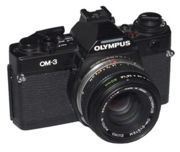
Olympus OM-3
Encyclopedia

Olympus Corporation
is a Japan-based manufacturer of optics and reprography products. Olympus was established on 12 October 1919, initially specializing in microscope and thermometer businesses. Its global headquarters are in Shinjuku, Tokyo, Japan, while its USA operations are based in Center Valley, Pennsylvania,...
OM-3 is a manual camera without automatic exposure modes, and an entirely mechanical shutter. Introduced in 1983, the OM-3 was the first of a new series of professional camera bodies designed to update the OM-1
Olympus OM-1
The Olympus OM-1 is a manually operated 35mm single-lens reflex camera, part of the Olympus OM system.-History:The very first model was presented at the Photokina of Köln in 1972 and was called the Olympus M-1...
and OM-2
Olympus OM-2
The Olympus OM-2 was a single-lens reflex system camera produced by Olympus of Japan.-Main Features:The Olympus OM-2 was an aperture priority automatic camera , based on the earlier, successful Olympus OM-1 body...
. These new bodies, which continued with the more popular OM-4
Olympus OM-4
The Olympus OM-4 is an interchangeable lens, 35 mm film, single lens reflex camera; manufactured by Olympus Optical Co., Ltd. in Japan and sold as OM-4 from 1983 to 1987 and as OM-4Ti from 1986 to 2002....
, included a number of refinements over their predecessors. Perhaps the most significant changes made were to the metering system. The OM-3 and OM-4 featured multi-spot metering in place of the centre-weighted metering on the earlier bodies. This allowed the user to take a number of spot meter readings, all of which were used by the camera to calculate the correct exposure. The system also featured "highlight" and "shadow" buttons which allowed the photographer to identify parts of a scene that should be exposed as white or black respectively. The metering system used a liquid crystal display in place of the older match needle design of the OM-1 and OM-2.
Other refinements were also present, including a faster maximum shutter speed of 1/2000 second and a built in flash hot shoe.
The OM-3 sold in smaller quantities than its electronic sister, the OM-4. This may be because the OM-1n remained in production and offered an alternative mechanical body for the OM system at a fraction of the price, albeit with less sophisticated metering. After a relatively short production run, the OM-3 was discontinued in 1986. As a result, OM-3 bodies today are much rarer than OM-4s, and those in good condition are highly sought after by collectors.
External links
- Olympus OM3 A user review of the Olympus OM-3.

